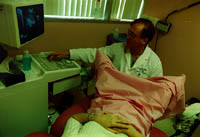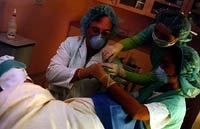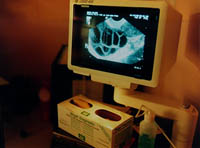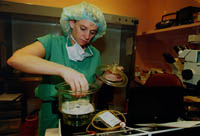2. PREPARING EGGS
 |
|
Dr. Sher uses ultrasound to check a patient's ovaries. The patient used
drugs to make her produce a large quantity of eggs. When they are mature
enough, Sher will remove as many as 20 eggs for fertilization in a
glass dish. In vitro literally means "in glass."
|
|
 |
|
Dr. Sher retrieves a patient's eggs. Using ultrasound to watch what he's
doing, Sher inserts a needle through the vaginal wall and into the ovary.
Fluid and eggs flow down a narrow hose into a test tube. The room is dimly
lit because sperm and eggs are accustomed to living in dark places.
|
|
 |
|
The screen shows a magnified image of a patient's ovaries during egg
retrieval. The large dark pockets are follicles which hold mature eggs. As
Dr. Sher draws the fluid and eggs out of them, they collapse.
|
|
 |
|
Embryologist Lisa Standing cleans eggs, separating them from the tissue
drawn from a patient's ovaries as a byproduct of the retrieval.
|
|
 |
|
Standing puts cleaned eggs into a dessicator.
|
|
 |
|
Doctors usually transfer only four or five embryos to a woman's uterus
after in vitro fertilization to avoid the risk of large multiple
pregnancies. IVF often results in extra embryos, so couples have them
frozen for later use. A lab worker shows rods that hold tiny embryos.
They're kept in a tank filled with a cryopreservative.
|
|
Next: Preparing Sperm
The Fertility Industry Home
|